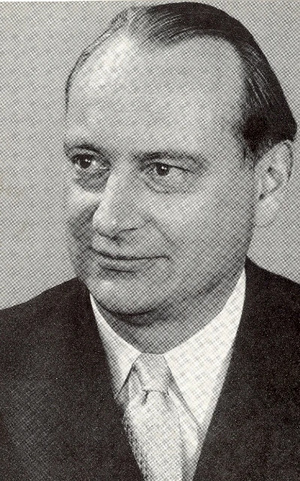Louis Ferdinand
| Louis Ferdinand | |||||
|---|---|---|---|---|---|
 | |||||
| King of Germany | |||||
| Reign | 1 January 1951 - 26 September 1994 | ||||
| Predecessor | Himself (as President of Germany) | ||||
| Successor | Georg Friedrich | ||||
| President of Germany | |||||
| In office | 16 November 1943 - 1 January 1951 | ||||
| Predecessor | Adolf Hitler (as Führer) | ||||
| Successor | Himself (as King of Germany) | ||||
| Chancellor of Germany | |||||
| In office | 16 November 1943 - 15 September 1949 | ||||
| Predecessor | Adolf Hitler | ||||
| Successor | Konrad Adenauer | ||||
| Born | 9 November 1908 Potsdam, German Empire | ||||
| Died | 24 September 1994 (aged 85) Berlin, Germany | ||||
| Burial | 1 October 1994 | ||||
| Spouse | Princess Benedikte of Denmark (m. 1968) | ||||
| Issue Detail |
| ||||
| |||||
| House | Hohenzollern | ||||
| Father | German Crown Prince Wilhelm | ||||
| Mother | Duchess Cecilie of Mecklenburg-Schwerin | ||||
| Religion | Lutheranism | ||||
Louis Ferdinand (Louis Ferdinand Victor Eduard Adalbert Michael Hubertus; 9 November 1908 - 26 September 1994) was King of Germany from 1 January 1951 to 26 September 1994. The son of German Crown Prince Wilhelm, Louis Ferdinand is the first monarch of post-war Germany following the restoration of the German monarchy as well as its longest-reigning monarch at forty-three years long. Prior to assuming the kingship, Louis Ferdinand was also president and chancellor of Germany during the last few years of the Second World War.
Born in 1908 during the reign of his grandfather Wilhelm II, Louis Ferdinand initially spent some of his childhood in the United States before later returning to Germany where he developed an interest in aviation. Following the outbreak of the Second World War in 1939, Louis Ferdinand, together with anti-Nazi officers, worked to undermine the Nazi regime from within, a task in which they ultimately succeeded with the assassination of Adolf Hitler in November 1943, effectively crippling the Nazi leadership. Following this, with the support of leading German military officers, Louis Ferdinand went on to assume the leadership position and subsequently negotiated a surrender with the Allies, thereby bringing the Second World War to an end. Then, with support from the United States and the United Kingdom, Louis Ferdinand was later proclaimed as the first King of Germany on 1 January 1951, the 80th anniversary of the proclamation of Wilhelm I as German Emperor.
As the head of state of post-war Germany, Louis Ferdinand was an active opponent of both fascism and communism and otherwise a public supporter of the concept of a welfare state via the advancement and promotion of Rhine capitalism. In addition, Louis Ferdinand was also a staunch supporter of the North Atlantic Treaty Organisation and the European Economic Community with the latter eventually becoming the European Union. Following the fall of the Soviet Union in 1991, Louis Ferdinand actively promoted rapprochement between Western European nations and the former Soviet states under a self-proclaimed vision of Größeres Europa ("Greater Europe"). In 1994, at the age of eighty-five, Louis Ferdinand passed away and was succeeded by his grandson, the reigning Georg Friedrich, having outlived his son and initial heir apparent Louis Ferdinand who died in 1977.
Having been married twice during his lifetime, Louis Ferdinand was first married to Grand Duchess Kira Kirillovna of Russia, with whom he had six children. Following Kira's death in 1967, around a year later, Louis Ferdinand remarried in a controversial fashion to Princess Benedikte of Denmark who is almost four decades younger. Nonetheless, the couple subsequently had three children together and their union lasted until Louis Ferdinand's death in 1994. Following this death, he was christened Louis Ferdinand the Great for his role in overthrowing the Nazi regime, ending the Second World War, and restoring the German monarchy after its previous abolition in 1919.